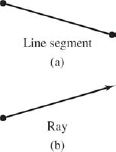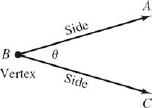6.1. Straight Lines and Angles
The straight line is not new to us, for we studied it in some detail in the last chapter. Here we will add a second straight line which intersects the first at an angle.
6.1.1. Angles
A line segment is that portion of a straight line lying between two endpoints [Fig. 6-2(a)]. A ray, or half-line, is the portion of a line lying to one side of a point (end-point) on the line [Fig. 6-2(b)].
Figure 6.2. FIGURE 6-2

An angle is formed when two rays intersect at their endpoints, Fig. 6-3. The point of intersection is called the vertex of the angle, and the two rays are called the sides of the angle.
Figure 6.3. An angle.

The angle shown in Fig. 6-3 can be designated in any of the following ways:
- angle ABC angle CBA angle B angle θ
The symbol ∟ means angle, so ∟ B means angle B.
An angle can also be thought of as having been generated by a ray turning from some initial position to a terminal position (Fig. 6-4). We adopt the usual convention that an angle is positive when formed by a counterclockwise rotation, as in the figure, and negative when formed by a clockwise rotation.
Figure 6.4. An angle formed by rotation.

One revolution is the amount a ray ...
Get Technical Mathematics, Sixth Edition now with the O’Reilly learning platform.
O’Reilly members experience books, live events, courses curated by job role, and more from O’Reilly and nearly 200 top publishers.

